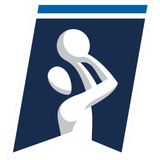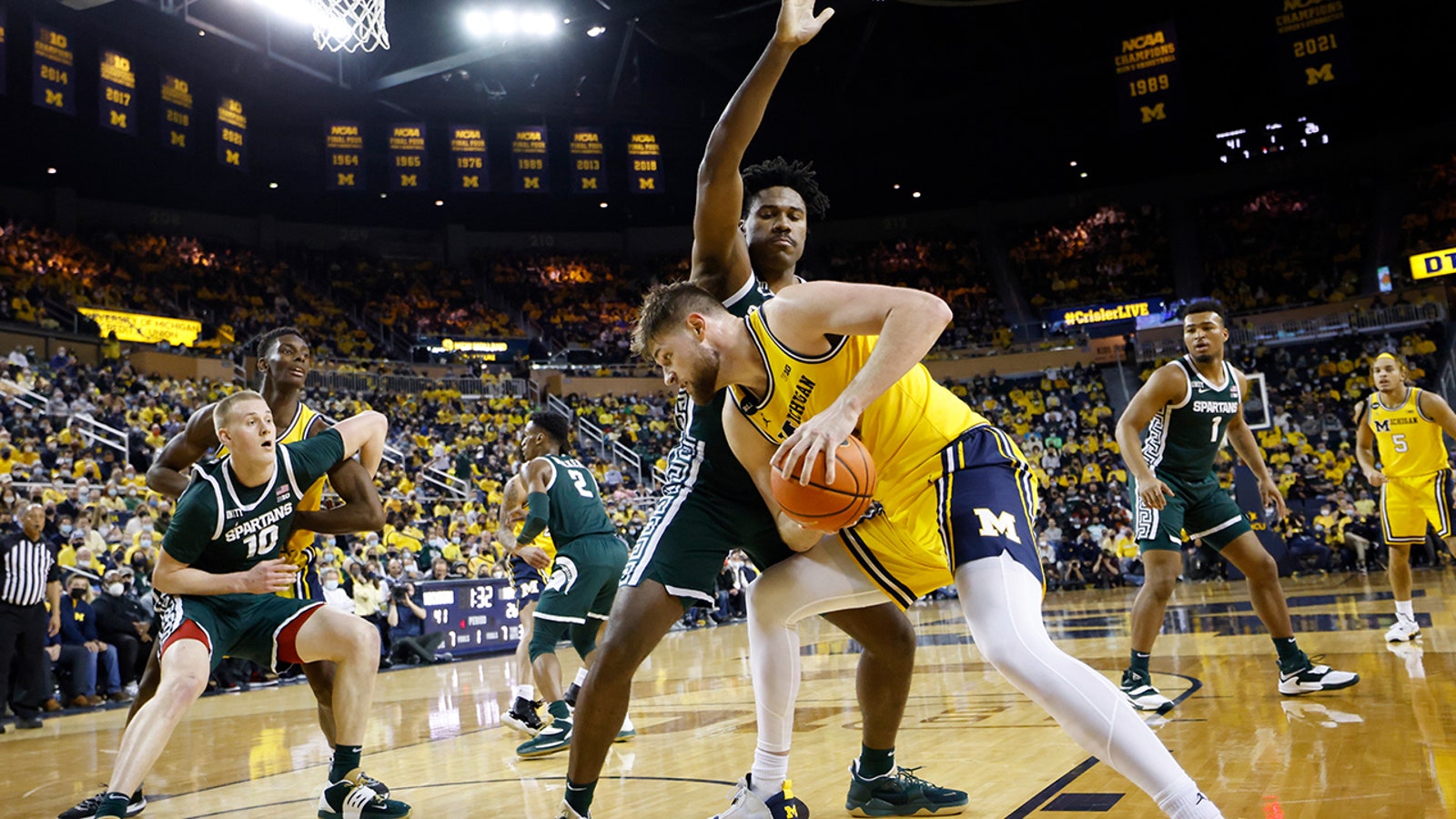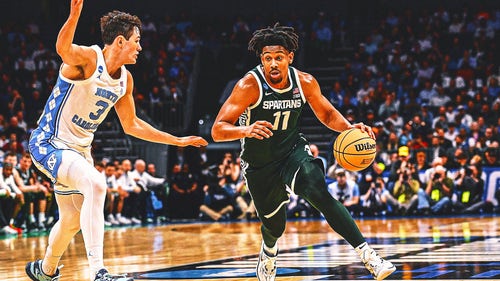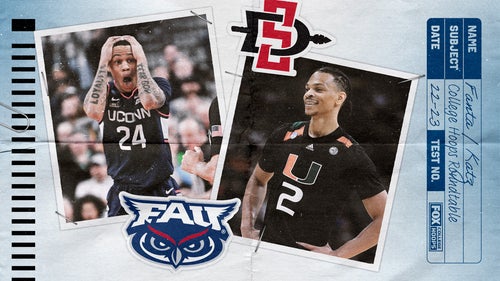
For Hunter Dickinson, a college star not quite on NBA's radar, NIL provided options
By Michael Cohen
FOX Sports College Writer
MINNEAPOLIS — On a Thursday morning in mid-August, Michigan basketball coach Juwan Howard addressed the media for the first time since his team lost to Villanova in the Sweet 16. The Wolverines were a few days from embarking on a summer tour of France and Greece, and Howard spent a half hour with local reporters to discuss his reconstructed roster.
Toward the end of that interview, Howard seized an opportunity to put pressure on athletic director Warde Manuel and the university’s administration. More than a year had passed since the NCAA approved Name, Image and Likeness (NIL) rules for athletes to profit off their individual brands, but Howard was displeased with Michigan’s sluggish approach relative to the national landscape.
"For us," Howard said, "NIL hasn’t hurt me or the team when it comes to recruiting from the transfer portal. Have the conversations of NIL been brought up in recruiting? Yes it has. Would I like to see more done for the program in a sense of some things that’s happening with other basketball programs? Yes.
"I know (my words are) going to be a storyline, and it’s OK. Do we have a collective here? No. Do other programs have collectives? Yes. Could we be more proactive with the NIL and use more forward-thinking? Yes. And I say we — I’m including myself — but our athletic department as well as Michigan as a whole, we can do better."

Juwan Howard speaks during Big Ten Media Days at Target Center on Oct. 12, 2022 in Minneapolis. (Photo by David Berding/Getty Images)
Two months later, the school’s poster child for NIL success settled into his seat on a raised platform at Big Ten Media Days earlier this week. Center Hunter Dickinson earned consensus All-America honors in 2021 to lay the foundation for an NIL journey more lucrative than any other on Michigan’s campus, regardless of sport, as he reaps the benefits of a unique middle ground more and more athletes will occupy: a player entrenched among the sport’s elite but whose skill set is only mildly enticing to NBA scouts and executives.
This meant that for the second consecutive summer Dickinson, who averaged 18.6 points and 8.6 rebounds per game last year, eschewed the chance to scratch out a two-way contract or keep a seat near the end of an NBA bench in favor of extending, exploring and strengthening his status as both the literal and figurative big man on Michigan’s campus. He arrived at Target Center on Wednesday wearing a custom navy-blue suit and diamond earrings in both ears, and told reporters the income from his arsenal of NIL deals funded, among other things, the purchase of a Ford Bronco.
"I really enjoy being at the University of Michigan," Dickinson said, "and I feel like there’s just more for me to do here.
"I think without NIL it would have been definitely a harder decision to make. But now with the opportunity to make money while you’re still in college, I think that definitely helps my decision and other guys like me."
Each of Dickinson's decisions to return was as much about acceptance as anything else. He explored the pre-draft process after a freshman season in which he averaged 14.1 points and 7.4 rebounds per game but was displeased with feedback from NBA decision-makers who labeled him a likely second-round pick. There were questions about how his defense (rim protection; pick-and-roll coverage), his athleticism (stiff runner; not a great jumper) and his shooting (0-for-4 from 3-point range as a freshman) would carry over to the NBA. Dickinson’s personal belief that he should be a first-round pick was harshly rebuffed.
In what felt like a compromise, Dickinson returned to Ann Arbor for his sophomore year but told reporters it would be his final season with the Wolverines — an assurance he now says was never as ironclad as it sounded. Dickinson became the focal point of Howard’s offense and increased his scoring (18.6 points per game), rebounding (8.6 per game), assists (2.3 per game) and blocks (1.5 per game) to cement his status as one of the Big Ten’s best players and prove to the NBA that his game could expand. He made 74 of 172 shots outside the paint (43%) during the 2021-22 campaign — including 21-for-64 from 3-point range (32.8%) — after attempting just 30 such shots the year before.
"I’m not going out there trying to shoot 10 3s a game just to show the NBA scouts," Dickinson said at last year’s Big Ten Media Days in Indianapolis. "I’m going to try to win the game and do a little bit of both. If I can apply that, I feel like that would definitely make us a more dangerous team and harder to guard."
Though he demonstrated statistical improvements across the board, Dickinson was unable to halt the erosion of his draft stock in the wing-heavy NBA. He tumbled out of most mock drafts by the time Michigan lost to Villanova in the Sweet 16, and his freshmen teammates Caleb Houstan (small forward) and Moussa Diabate (power forward) were viewed as better prospects given their youth and better positional fits in the modern game.
That Dickinson isn’t the only collegiate star whose skills choppily translate to the NBA underscores one of the largest schisms in player evaluation between the two levels. Where conferences like the Big Ten are known for hoarding exceptional centers — Dickinson and Purdue’s Zach Edey (7-foot-4, 290 pounds) are atop the list this season — the professional ranks have weeded out most of the traditional, back-to-the-basket big men in favor of smaller, nimbler players who can stretch the floor with perimeter jumpers.
Hunter Dickinson dominates Spartans
In Minneapolis this week, Illinois coach Brad Underwood told reporters he woke up each morning with an understanding that burly center Kofi Cockburn (7-foot, 293 pounds) would give him 20 points and 10 rebounds on a nightly basis last season. Cockburn earned consensus All-America honors after averaging 20.9 points and 10.6 rebounds (17 double-doubles) before tossing aside his remaining eligibility to enter the draft. All 30 teams passed on Cockburn, who remains a free agent.
"The Big Ten is really unlike any other conference in the country in terms of how dominant the center play has been the last couple years," Ohio State coach Chris Holtmann said this week.
And that’s why NIL deals have become so important for players like Dickinson, Edey and Indiana standout Trayce Jackson-Davis (6-foot-9, 245 pounds) — all of whom could win Big Ten Player of the Year this season, but whose NBA futures are complicated by physical constraints, adaptability concerns or both. Their earning power in college provides an intriguing alternative to professional uncertainty.
Dickinson sits 31st nationally for all sports and fifth for college basketball in the On3 NIL valuation rankings that calculate a player’s monetary value with an algorithm tracking performance, influence and exposure. The college basketball player with the highest NIL valuation is Texas Southern center Shaqir O’Neal ($1.1 million), the son of former NBA star Shaquille O’Neal. Behind him are North Carolina’s Armando Bacot ($1 million), Kentucky’s Oscar Tshiebwe ($915K), Gonzaga’s Drew Timme ($912K) and Dickinson ($868K), whose deals have included his own clothing line and various endorsements for a tutoring company, local businesses and the chain restaurant Outback Steakhouse.
Jackson-Davis ($606K), Edey ($348K) and Illinois’ Skyy Clark ($207K) are the only other Big Ten players in the top 40 for college basketball valuations.
"It’s a huge part of the game," Jackson-Davis said this week, "and it’s a part that’s kind of still in the unknown. But I think it’s going to be huge for college athletes that are kind of on the brink — they don’t know if they should go to the NBA yet or play professional basketball or stay in college. So I think it’s huge for them, huge for all of us, to make money."
In some respects, Dickinson was destined to be an NIL wunderkind. He earned Gatorade Player of the Year honors in Maryland while playing for powerhouse DeMatha Catholic in 2020. He was named the Big Ten’s Freshman of the Year after averaging 14.1 points and 7.4 rebounds per game en route to the Elite Eight during Howard’s first NCAA Tournament appearance. He’s racked up 17 double-doubles in Ann Arbor and scored at least 20 points in 15 games last season alone.
That’s the basketball side of his valuation.
Hunter Dickinson's Twitter feud with Texas Tech coach
The other component is Dickinson’s outsized personality. Dickinson flashed his mischievous side by designing a personal clothing line built around the slogan "BIG D1CKINSON ENERGY" in reference to a pop culture phrase that equates phallic size to confidence. He enjoys trolling opposing fan bases on social media and taunting them in Big Ten arenas. He made a guest appearance on FOX’s Big Noon Kickoff before a Michigan football game earlier this season, and associate head coach Phil Martelli says Dickinson has all the traits of a prototypical wrestling villain.
"I really enjoy my time at Michigan," Dickinson said, "so that kind of makes it easy for me to come back."
With NIL, it finally pays to be the big man on campus.
Michael Cohen covers college football and basketball for FOX Sports with an emphasis on the Big Ten. Follow him on Twitter at @Michael_Cohen13.











































































































































